
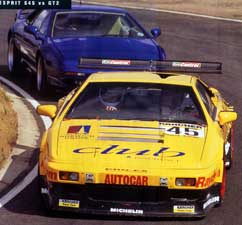
ESPRIT de War
A GT2 car this good
could only come from a road car like the S4s
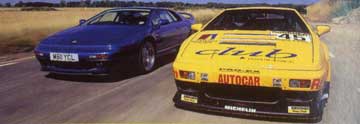
Autocar
Magazine, August 1995
by Andrew Frankel
I was told I would stall four times and not to feel too bad about it. Apparently, everybody stalls the Lotus Esprit ST2 four times when they first drive it.
Well, not me. I stalled it five times and my eventual getaway was only marginally less graceful than a newborn giraffe learning to walk. No matter, I was on a track in the Esprit GT2, the car that, in the only round of the BPR sportscar championship it contested, proved much faster than every other GT2 sportscar. So much so that, when it retired just eight minutes from the flag, it was well over a lap ahead of any other car in its class.
I slowly familiarised myself with the uniquely focused surroundings of a racing car. Meanwhile, I recalled the last few laps of Lotus's test track I had completed in this car's road-going equivalent, the Esprit S4s. That car is so special that, no matter how many times you climb aboard, it is always a bit better than you remembered. The noise of a Ferrari F512M, the gearchange of a Mazada MX-5, the agility of a Caterham 7 are all impossible to overhype in your own mind – and so it is with the chassis of an S4s.
Around the track – a boomerang-shaped affair with two hairpins connected by terrifically fast straights and curves – the S4s felt better than ever. Softly suspended by supercar standards but controlled to the last degree, the Esprit made light work of this unforgiving circuit. It resisted understeer like few mid-engined cars I know, yet remained stable even through the monstrous windsock corner, a sweeping fourth gear bend with an apex as late as it is blind. Its balance was as impressive as its poise, its on-limit forgiveness more memorable even than the legendary Esprit grip.
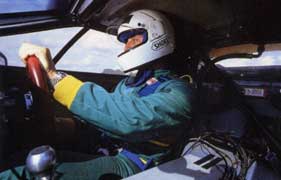
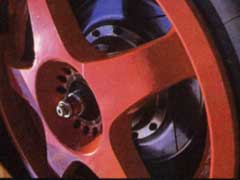
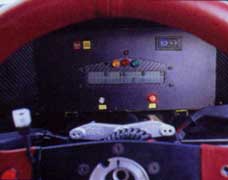
Sitting beside me was George Howard-Chappell, manager of the Lotus GT Team, chief development driver for the Esprit GT2, Esprit club racer and ex-Lotus Formula 1 team engineer. He pondered out loud whether the road-going Esprit handling balance wasn't a shade too neutral for Lotus's average customer.
When I climbed out, he slotted into the driver's seat for some seriously fast laps. Our aim was to log as accurately as we could the performance differential between a front-row supercar and its all-out racing equivalent. We had the technology, from standard speed measuring equipment to a full telemetry system bought from the bankrupt Lotus F1 team. It logged every touch on the throttle and very dab of the brakes. Every shred of data from such basic essentials as an overall lap time to minutiae such as the time lost changing gear would be logged.
Howard-Chappell set a bogey time of 1:29.57sec in the S4s while I sized up the GT2. Like the McLarens, Honda NSXs, Porsche 911s, Ferrari F40s and the many other GTs that race in the world's most prestigious sportscar championship, the Esprit is no silhouette racer. Inside lie an Esprit engine and Esprit suspension, albeit both highly modified.
The engine is the same 2174cc unit that first saw service in the Lotus 64 in 1968 and has powered every Lotus for the last generation. In road-going S4s trim it produces 285bhp yet the racer, using standard pistons, rods and valves, thumps out 375bhp in race trim and a little over 400bhp in qualifying. It achieves this with a little detail tuning – one camshaft is standard, the other from a Sunbeam Lotus rally car – and one big turbo. Lotus is among the few teams unaffected by the size of restrictor the rules require. The engine could legally be wound up to at least 450bhp but, figures Lotus, why bother risking reliability when it's already far and away the fastest GT2 out there?
The secret of its speed is not its power, as anyone driving one of the 480bhp Porsche 911 GT2 cars this Esprit walked all over at Donington will attest. In the finest Lotus tradition, its secret is its weigh. Right now it tips the scales at just 917kg, fully 30 per cent less than the S4s. In qualifying trim this gives a power-to-weight ratio of 436bhp per tonne. That's not far off being double the 221bhp per tonne possessed by the road car, itself capable of 162mph and 0-60mph in 4.7sec.
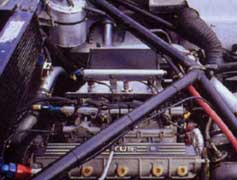
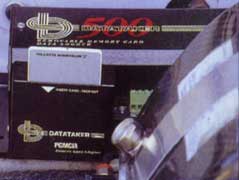
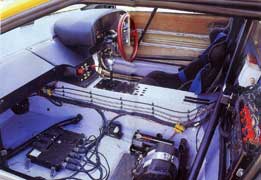
Next season Lotus will race the Esprit in the big boys' GT1 category. By then it will not only weigh 900kg, absolute zero for a sportscar, but will also be powered by Lotus's all-new twin-turbo 3.5-litre V8. This engine is rumoured to be pushing out 550bhp in race trim, giving a power-to-weight ratio of about 610bhp per tonne – enough even to worry the sovereign McLarens.
Back at Lotus's test track, though, I was content with only four cylinders and a single turbo. I've driven the McLaren racer but, for many reasons – largely the combination of slick tyres on a damp and unfamiliar track, the car's £750,000 value and that big yellow streak I call a backbone – I was almost completely cowed by the experience. In those six laps, I'm afraid I learned rather more about myself than the car.
The Esprit experience was not like that. It helped that I knew the track and that it was dry. However, it was my knowledge of Lotus and its record as maker of the most consistently excellent car chassis in the world that helped most. After the first few exploratory laps to pump some heat into the slicks and learn my way around the five-speed dog-leg Hewland gearbox, there no longer seemed any reason to hang around.
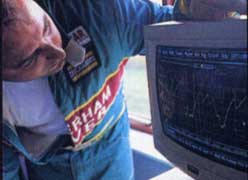
I came in and had a chat with Howard-Chappell. He seemed pleased that I hadn't wrapped his GT2 around any one of a multitude of hard objects there are to hit at Hethel. He even pressed the button which gave me full race boost, instead of a namby-pamby 350bhp or so I'd hitherto been allowed to play with.
It's amazing what a bit of confidence and an extra 25bhp can do for your lap times. Lap after lap I felt able to push a little harder, eventually using fifth gear for the curves and, for the first time in my life, really feeling wing and venturi-generated downforce begin to dominate the handling. It became intoxicating – the faster I went, the better it felt. This Lotus has exactly half the downforce of the last Lotus F1 car which, by any other standards, is a huge amount of air pressure sucking the car on to the road.
I shudder to think what would happen when the limit of the wind-assisted slicks was finally broken in a fifth gear corner. All I know is that at my own maximum effort – enough to get the sparks flying and the steering kicking as I turned into the windsock corner – the GT2 felt more stable and secure than any car I've ever driven at speed.
I wanted more time with the Lotus but, above all, I wanted more power, a desire I never imagined I'd harbour before climbing aboard. All I knew about the grip limit was that it would understeer progressively through the hairpins and respond faithfully to any throttle-fed request to my chosen line. In the fifth gear sweeps, I doubt I even got close.
Even so, I can see why Zanardi was able to drive around the outside of other GT2 competitors at Donington and why he loves the Esprit's natural balance and ability to carry speed through a corner.

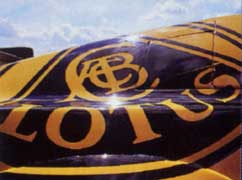
To me, the Esprit GT2 felt further removed from the S4s than did the McLaren GTR from its road-going equivalent. Not simply because, unlike the GTR, it was so much quicker in a straight line but because it still felt related to the Esprit – a distant cousin rather than a snazzy twin brother.
The data from Hethel rather confirmed the night and day performance differential separating a Lotus supercar from a Lotus racing car. Staggeringly, the speed differential at the end of the main straight was nearly 20mph, while the GT2 would blast through any on of the three fifth gear sweeps 10mph or 10 per cent more swiftly than the S4s. Anyone who knows the phenomenal limits of an S4s will appreciate the scale of this achievement. Over the entire lap, the GT2 was a clear 10 sec ahead of the S4s, a gap which could only widen with further experimentation.
But what is perhaps most extraordinary of all is that, for Lotus, this Esprit is no more than a stepping stone to greater things. It was built to rekindle interest and to dry-run the Esprit chassis for the rather more serious business to come – an all-out assault on GT1 next year. To do that, the 20-year-old Esprit must take on the might of McLaren – and win. It will do it with the new V8, combining a works entry with customer cars it will sell for £150,000 apiece.
The goal is not to get a few podiums, win a race and have a serious go for the title in 1997. It is Lotus's clear and stated aim to win the championship straight out of the box. As the search for sponsors continues, it is entirely in Lotus's interest to talk up the project. But think about this: the fact that the Esprit simply drove away from the other GT2 competitors, despite having up to 100bhp less, would suggest there is little wrong with the chassis. The GT1 Esprit will use a further modified, still lighter version of that chassis complete with carbon brakes and half as much power again.
If I was a privateer looking for a way to combat the deserved dominance of the McLaren, I'd be thinking about that. And not just because the Esprit is British, nor simply because it's a works-developed Lotus. I think the fact that the company will sell you five for the price of just one McLaren would weigh pretty heavily on my mind, too. •
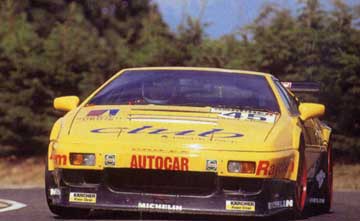
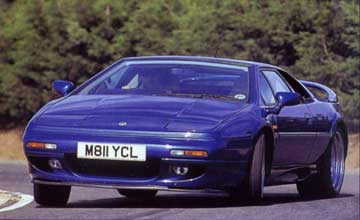
FACTFILE
Lotus Esprit S4s
HOW FAST?
Max speed on straight: 127mph
Hairpin corner: 49mph
Factory corner: 95mph
Clubhouse corner: 94mph
Steering pad corner: 38mph
Windsock corner: 96mph
Overall lap time: 1min 29.57secHOW BIG?
Length: 4414mm
Width: 1883mm
Height: 1150mm
Wheelbase: 2420mm
Front track: 1520mm
Rear track: 1520mm
Weight: 1347kg
Fuel tank: 73 litresENGINE
Max power: 285bhp @ 6400rpm
Specific output: 130bhp per litre
Power to weight: 212bhp per tonne
Capacity: 2174cc, 4 cylinders in line
Bore/stroke: 95/77mm
Valves: 4 per cylinder, dohcGEARBOX
Type: Renault all-syncromesh 5-speed manualSUSPENSION
Front: wishbones, coils, anti-roll bar
Rear: lateral links and trailing arms, anti-roll barSTEERING
Type: rack and pinion, power assistedBRAKES
Front: 296mm ventilated discs
Rear: 300mm ventilated discs Anti-lock standardWHEELS & TYRES
Size: 8.5x17 (f) 10x18 (r) Made of alloy
Tyres: 235/40 ZR17 (f), 285/35 ZR18 (r)
Lotus Esprit GT2
HOW FAST?
Max speed on straight: 146mph
Hairpin corner: 56mph
Factory corner: 106mph
Clubhouse corner: 103mph
Steering pad corner: 52mph
Windsock corner: 106mph
Overall lap time: 1min 18.71secHOW BIG?
Length: 4300mm
Width: 1950mm
Height: 1100mm
Wheelbase: 2440mm
Front track: 1540mm
Rear track: 1624mm
Weight: 917kg
Fuel tank: 100 litresENGINE
Max power: 400bhp @ 7200rpm
Specific output: 184bhp per litre
Power to weight: 436bhp per tonne
Capacity: 2174cc, 4 cylinders in line
Bore/stroke: 95/77mm
Valves: 4 per cylinder, dohcGEARBOX
Type: Hewland straight-cut 5-speed manualSUSPENSION
Front: wishbones, coils, anti-roll bar
Rear: lateral links and trailing arms, anti-roll barSTEERING
Type: rack and pinion, unassistedBRAKES
Front: 330mm ventilated discs, 6-pot calipers
Rear: 330mm ventilated discs, 4-pot calipersWHEELS & TYRES
Size: 9x18 (f) 11x18 (r) Made of magnesium
Tyres: 24/64 -18 (f), 27/65 -18 (r) Michelin slicks
|
|